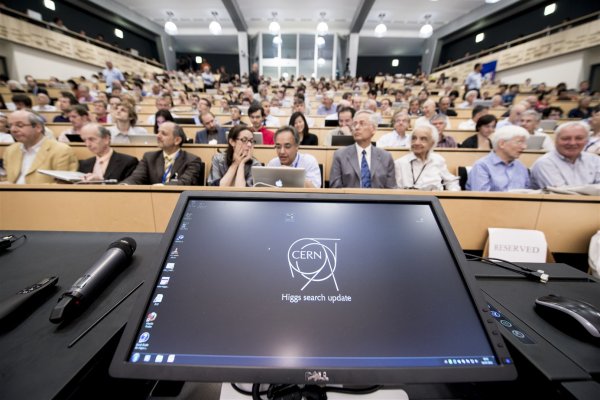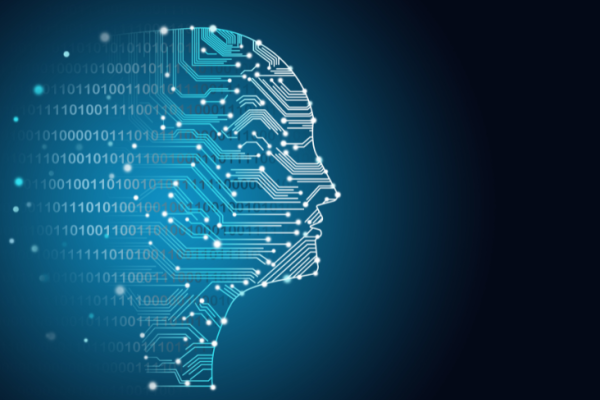The historic discovery of the Higgs boson at the Large Hadron Collider exactly ten years ago and the progress made since then has allowed the scientific community to make huge strides in our understanding of the universe.
Exactly ten years ago, on July 4, 2012, the ATLAS and CMS collaborations at CERN's Large Hadron Collider (LHC) announced the discovery of a new particle with characteristics consistent with those of the Higgs boson. The discovery marked a milestone in the history of science and captured worldwide attention. A year later, François Englert and Peter Higgs were honored with the Nobel Prize in Physics, because in the 1960s, together with the late Robert Brout, they predicted the existence of a new fundamental field, known as the Higgs field, which fills the universe, manifests itself as the Higgs boson and gives mass to elementary particles.
"The discovery of the Higgs boson was a monumental milestone in particle physics. It marked the end of a long research journey that lasted decades and the beginning of a new era of studies focused on this very special particle," explains Fabiola Gianotti, Director General of CERN and spokesperson for the ATLAS experiment at the time of discovery. "I remember the day of the announcement, a day of immense joy for the global particle physics community and for all the people who worked tirelessly for decades to make this discovery possible."
How has it been going so far?
The new particle discovered by international collaborations ATLAS and CMS in 2012 closely resembled the Higgs boson predicted by the Standard Model. But was it really that much-sought-after particle? As soon as the discovery occurred, ATLAS and CMS began to investigate in detail whether the properties of the particle they had discovered actually matched the characteristics predicted by the Standard Model.
Using data collected during the decay phenomenon of this new particle into two photons, experiments have shown that this new particle has no intrinsic angular momentum, or quantum spin, which matches the predictions of the Higgs boson obtained with the Standard Model. In contrast, all other known elementary particles do have spin.
Furthermore, by observing that Higgs bosons are produced and decayed into pairs of W or Z bosons, ATLAS and CMS confirmed that the latter acquire their mass through their interactions with the Higgs field, also as predicted by the Standard Model.
Experiments have also shown that the top quark, bottom quark, and tau lepton, which are the heaviest fermions, get their mass from their interactions with the Higgs field, again as predicted by the Standard Model. These observations also confirmed the existence of an interaction, or force, called the Yukawa interaction, which is part of the Standard Model, but is different from all other forces in the model: it is mediated by the Higgs boson and its force is not quantized, that is, it is not given by multiples of a given unit.
ATLAS and CMS measured the mass of the Higgs boson resulting in the value of 125 billion electron volts (125 GeV), with an impressive accuracy of almost one per thousand. Knowing this value is important, because together with the mass of the heaviest known elementary particle, the top quark, and other parameters, the mass of the Higgs boson can help us determine the stability of the vacuum of the universe.
There is still a lot of research ahead
What remains to be learned about the Higgs field and the Higgs boson ten years later? A lot. Does the Higgs field also give mass to lighter fermions or could there be another mechanism at play? Is the Higgs boson an elementary or compound particle? Can it interact with dark matter and reveal the nature of this mysterious form of matter? What generates the mass of the Higgs boson? Does it have 'twins' or 'relatives'?
Finding the answers to these and other questions will not only contribute to our understanding of the universe at its smallest scales, but it can also help us unravel some of the greatest mysteries of the universe as a whole, such as how it came to be as it is and what its ultimate fate might be.
"The Higgs boson itself may point to new phenomena, including some that could be responsible for dark matter in the universe," says CMS spokesman Luca Malgeri. "ATLAS and CMS are conducting many searches to probe all types of unexpected processes involving the Higgs boson."
While the answers to some of these questions could be provided by data collected during the LHC's upcoming and imminent Run 3 or in subsequent periods of accelerator operation, it is believed that the answers to other puzzles are beyond the reach of the LHC, requiring a future "Higgs factory". For this reason, CERN and its international partners are investigating the technical and financial feasibility of a much larger and more powerful machine, the Future Circular Collider (FCC).
"High-energy colliders remain the most powerful microscope we have to explore nature at the smallest scales and discover the fundamental laws that govern the universe," says Gian Giudice, head of CERN's Theory department.
SPANISH PERSPECTIVE ON THE DISCOVERY OF THE HIGGS BOSON
The Spanish research community had, and continues to have, a very important role in CERN's ATLAS AND CMS collaborations, the experiments that announced the sighting of the Higgs boson on July 4, 2012.
Since the start-up of the ATLAS detector, researchers from the Institute of High Energy Physics (IFAE), the Institute of Corpuscular Physics (IFIC), the Institute of Microelectronics of Barcelona (IMB-CNM) and the Autonomous University of Madrid (UAM) have participated in it.
On the other hand, the national presence also stands out in the CMS program since the beginning of this experiment. The groups of the Center for Energy, Environmental and Technological Research (CIEMAT), Institute of Physics of Cantabria (IFCA), Autonomous University of Madrid (UAM) and the University of Oviedo (UO), and more recently, researchers from the Technological Institute of Aragon (ITAINNOVA) and the National Center for Microelectronics (CNM) have joined the CMS collaboration.
Carlos Lacasta, researcher at IFIC, and Celso Martínez, researcher at IFCA, are currently the Spanish Representatives of ATLAS and CMS, respectively. This position is designated as National Contact Physicist and the person in charge acts as a contact between the collaboration (ATLAS or CMS, in this case) and Spain. In the following lines, Lacasta and Martínez tell the CPAN what the discovery of the Higgs boson meant and how this milestone was lived from Spain.
The discovery of the Higgs boson: a perennial news
"The discovery of the Higgs boson is news that will remain alive for a long time: it will always be remembered that in July 2012 CERN showed us that a 125 GeV particle, very similar to the Higgs boson, which had appeared in two different experiments, ATLAS and CMS, and two of the three people who had thought of that boson almost 50 years before, Englert and Higgs were even still alive.", explains Celso Martínez. "For everyone it was very important, but for Teresa Rodrigo (Note: in the picture, fourth person on the left) it was something very special, being the Chairperson of the COLLABORATION Board of CMS," Martínez adds, recalling her late colleague, also a researcher at IFCA.
"The discovery of the Higgs boson is and has been very important for several reasons. The first and fundamental is that it is a type of particle that has never been seen in a detector until now. In addition, we think that it is a fundamental particle, meaning that it is not formed by others. We have discovered something that, although it was theorized about for a long time, it is really new and we need to focus on knowing the properties of this new particle", says Carlos Lacasta. He continues: "The second reason is the boson's history. It was predicted back in 1964 to solve a problem that theoretical models had when calculating the numerical values of the observables that we could measure in experiments. Introducing the Higgs boson allowed these calculations to be made. Now, we had to find it and, with the knowledge and technology we had then, it was already clear that it was not going to be an easy task."
Not an easy task
"Having searched – unsuccessfully – for the Higgs boson in the Large Electron and Positron Collider (LEP), the predecessor of the LHC, we knew that something had to appear in the LHC. And so it was: at the end of 2011 we saw that in the 125 GeV zone there was 'something' there. The meetings in which we shared the analyses related to the Higgs boson became more and more frequent, until in recent months they happened daily. In the end we knew this was the Higgs boson.... there was no other solution," Martinez explains to the CPAN.
For his part, Lacasta underlines the technological development it took to find this elusive boson: "The search for the Higgs boson was not easy at all. In fact, it took 50 years to accomplish. The Higgs is a particle predicted by a theoretical model unable to predict what mass that particle has and, therefore, we had to start looking for it without knowing what energy the accelerators had to have to produce it. To give you an idea of the technological challenges that had to be faced, I will tell you that of the 50 years it has taken to "find the Higgs boson", 30 have been dedicated to the design and construction of the accelerator (the LHC) and the detectors (ATLAS and CMS) that first sighted it."
A unique and inexplicable emotion
"During the discovery there was a lot of emotion, the result of a titanic effort at the international level not only to develop the technologies that made it possible, but to 'manage' the international collaborations themselves, whose number of participants has grown abruptly in recent decades. From Spain it was also very special. The Spanish research community played a very important role in some of the aspects of the design, construction and operation of the detectors as well as in the generation of algorithms to search for and find among the millions of events produced those in which there could be a Higgs boson, "says Lacasta.
"The meetings, analyses, counter-analysis and the actual Higss boson candidates, which were reviewed one by one, kept us very busy in 2011 and 2012, but we did it with great enthusiasm. Discovering a new particle is something that rarely happens in the lifetime of an experimental particle physicist," says Martínez. Lacasta shares his emotion: "You can't always say you've contributed to the discovery of a new particle, so you can imagine the excitement of the moment."



